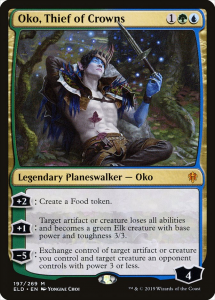Table of Contents
When Oko, Thief of Crowns was released, he changed Standard as we knew it…while he was legal, anyway. He was overwhelmingly powerful, and came to be used in tons of decks.
Eventually, he was banned because of the way he was breaking formats. If you’re not familiar with him, though, you might not understand what made him so strong.
So, in this post, we’ll be addressing why Oko is so good in MTG. You should have a better understanding of how he works by the end of this article.
Intro to Oko, Thief of Crowns

Oko is a card that is loved by many…and hated by even more. And all of this has nothing to do with the fact that he’s just dang good-looking.
He’s a mythic that was released in the Throne of Eldraine set. When he was initially spoiled, he actually didn’t see a lot of hype. On paper, he doesn’t look as awesome as he actually is.
However, as he was played more, it was found that he had way more power than people thought at first. As a result, he ended up being banned in the Standard, Pioneer, Brawl, Modern, and Historic formats.
Here’s the brief lifespan he got to enjoy in a few different formats before swiftly becoming the next victim of the almighty ban hammer:
- 45 days in Standard
- 73 days in Pioneer
- 101 days in Modern
Here’s Why Oko is so Good
At three mana, he’s extremely cheap.
This one is self-explanatory. Despite being such a powerful card, Oko only costs you three mana to cast, which means you can get him out pretty early on in the game.
Much of the time, players found ways to get him on the board on turn two, then started immediately making food with him.
He also comes in hot (in more ways than one *wink**wink*) with four loyalty counters, which brings him out of range for most burn spells your opponents might hit him with. His decent amount of starting loyalty counters combined with a +2 ability makes it so he gains loyalty counters fast, making it even harder for him to be removed.
Making food is actually useful.
At a glance, some people might scoff at Oko’s first ability, which creates a food token. But this is way more useful than you might expect.
Each food token you create can be turned into a 3/3 elk with Oko’s second ability. This way, you can rapidly build a decent army out of nothing more than food tokens.
Alternatively, you can turn opponents’ creatures into elks and trade your food for them. This increases your lead even more, and smacks your opponent down.
He gives you a pseudo-card advantage.
Card advantage usually means you’re able to draw extra cards. Oko doesn’t possess any ability that allows you to do this, but he does, in a way, force your opponent to draw more cards to deal with him.
He gains loyalty counters quickly. This means your opponents usually need to invest a lot of cards to get rid of him.
Many of his abilities are more oppressive and push games to a slower pace. That further contributes to the number of cards needed to effectively eliminate him.
Even though he doesn’t draw you cards, he still creates a kind of pseudo-card advantage for you by forcing your enemies to burn through cards of their own.
He allows you to trade for food.
If you stabilize and are able to protect Oko, he can continue to tick up in loyalty counters. Then you can use his -5 ability to trade your food for useful creatures…or just steal everything from your opponent to add some extra insult to injury. (They don’t call him the Thief of Crowns for no reason!)
Because of this, there’s usually a huge target painted on him the instant he hits the battlefield. Like we mentioned previously, your opponents will continuously spend cards trying to remove him. Closing out the game to your benefit with other cards becomes relatively easy while they’re distracted with Oko.
Now Here are the Drawbacks to Using Oko…
He’s so oppressive that he’s not fun to play against.
Being oppressive to your opponents might be the most important thing to you if all you care about is winning. But at the end of the day, Magic: the Gathering is still a game, and it should be a pleasure to play it.
Playing a card like Oko can take some of the fun out of the game. He can take care of most creatures and build you a literal army using nothing but food tokens.
Because of this, other players aren’t as likely to have fun. If you’re playing him against you friends regularly, you might find them wanting to play with you less and less.
Playing him tends to make games really long.
We’ve all played some board or card game that went on much longer than we anticipated. (Here’s looking at you, Monopoly or Arkham Horror…) Magic: the Gathering can be the same way, with some games dragging on well past their expiration date.
Oko is really good at dragging games out. If you are playing competitively or trying to grind in a format online, this can be an issue because you want to close out games quickly…not stay in the same one for hours.
Even if you’re playing casually with friends, dragging games out can be annoying. People are likely to get frustrated when they’re caught in a never-ending game and would rather do something else.
When he was legal, he dominated formats.
For the brief period of time he was legal in various formats, he was used in the vast majority of winning decks. This was actually one of the reasons he ended up being banned.
Wizards of the Coast said that he turned Standard into an “unhealthy state.” Since most decks used him, he largely took the creativity and ingenuity out of deck-building.
We’d argue that building meta decks is quite boring. You should be striving to create your own unique builds to get the most fun out of formats.
If everything is an Oko deck, it loses much of the spark which draws creative players to Magic: the Gathering in the first place.
Playing Oko gets pretty repetitive.
When you cast Oko, the game becomes this boring cycle of the same goals and steps. Protect Oko, make food, turn things into elks…rinse and repeat.
Many players find this to be really uninteresting. It gets stale fast and doesn’t make for a fun game.
His monetary cost has been high.
At his peak, Oko cost around $70. For one of him, that might not be enough to steer dedicated players away, but consider the fact that most people played four of him in one deck.
When he was at his highest price, this meant you’d have to spend almost $300 just to build with him. That isn’t mere pocket change.
We at Renegade Outplayed love budget decks. They test our creativity the most, because you need to use limited resources to build something strong. Because of our soft spot for budget decks, the cost of Oko was a huge downside.
Since being banned in multiple formats, his cost has subsequently dipped. However, he’s still somewhat pricier than the average card.
Wrap Up
Oko, Thief of Crowns swept multiple formats by storm when he was released. It’s true that he’s an amazingly powerful card that can make you battalions of creatures out of food…but he does have his drawbacks, like being repetitive and costly.
One fact remains, though: he may be called the Thief of Crowns, but he also stole our hearts.
